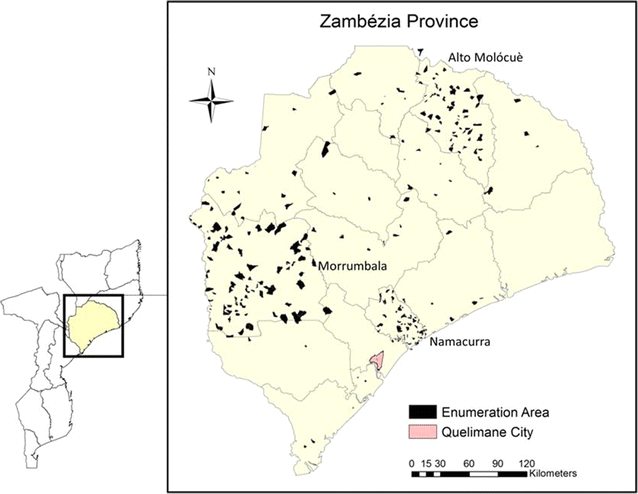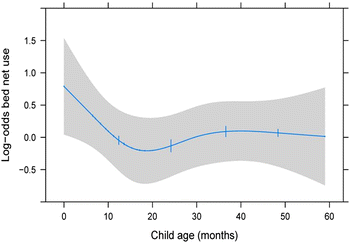Factors associated with the use of mosquito bed nets: results from two cross-sectional household surveys in Zambézia Province, Mozambique
- PMID: 27068575
- PMCID: PMC4827200
- DOI: 10.1186/s12936-016-1250-5
Factors associated with the use of mosquito bed nets: results from two cross-sectional household surveys in Zambézia Province, Mozambique
Abstract
Background: Malaria remains a major threat to some 3.2 billion persons globally. Malaria contributes heavily to the overall disease burden in Mozambique and is considered endemic. A cornerstone of Mozambique's vector control strategy has been to strive for universal coverage of insecticide-treated nets (ITN).
Methods: The study is a population-based cross-sectional survey of female heads-of-household in Zambézia Province, Mozambique conducted during August-September, 2010 and April-May, 2014. Analyses accounted for a stratified two-stage cluster sample design. Outcomes of interest included sleeping under a mosquito net during the previous night. Descriptive statistics were calculated for three oversampled districts and for the entire province. Multivariable logistic regression analysis was used to estimate factors associated with both changes over time and increased mosquito bed net usage.
Results: Of the 3916 households interviewed in 2010 and 3906 households in 2014, 64.3% were in possession of at least one mosquito bed net. A higher proportion of households in Namacurra (90%) reported possession of a mosquito net, compared to Alto Molócuè (77%) and Morrumbala (34%), respectively in 2014. Of pregnant respondents, 58.6% reported sleeping under a mosquito net the previous night in 2010 compared to 68.4% in 2014. Fifty percent of children 0-59 months slept under a mosquito net the previous night in 2010 compared to 60% in 2014. Factors associated with use of a mosquito net for female head-of-household respondents were higher education, understanding Portuguese, larger household size, having electricity in the household, and larger household monthly income. As travel time to a health facility increased (per 1 h), respondents had 13% lower odds of sleeping under a mosquito net (OR 0.87; 95% CI 0.74-1.01, p = 0.07). Pregnant women in 2014 had a 2.4 times higher odds of sleeping under a bed net if they lived in Namacurra compared to Alto Molócuè (95% CI 0.91-6.32, p = 0.002 for district). Higher maternal education, living in Namacurra, and acquisition of mosquito bed nets were associated with a child 0-59 months reporting sleeping under the net in the previous night in 2014.
Conclusions: Intensified focus on the poorest, least educated, and most distant from health services is needed to improve equity of ITN availability and usage. Additionally, while some districts have already surpassed goals in terms of coverage and utilization of ITN, renewed emphasis should be placed on bringing all geographic regions of the province closer to meeting these targets.
Keywords: Long-lasting insecticide treated bed nets; Malaria; Mozambique; Prevention.
Figures


References
-
- WHO. World Malaria Report. Geneva: World Health Organization; 2015. http://www.who.int/malaria/publications/world-malaria-report-2015/report.... Accessed 15 Mar 2016.
-
- Mortality in Mozambique. Results from a 2007–2008 Post-Census Mortality Survey—MEASURE evaluation. http://www.cpc.unc.edu/measure/resources/publications/tr-11-83. Accessed 04 Jan 2016.
-
- Moçambique Inquérito Demográfico e de Saúde 2011. http://dhsprogram.com/pubs/pdf/FR266/FR266.pdf. Accessed 04 Jan 2016.
-
- President’s Malaria Initiative Mozambique Malaria Operational Plan FY 2015. http://www.pmi.gov/docs/default-source/default-document-library/malaria-.... Accessed 04 Jan 2016.
MeSH terms
LinkOut - more resources
Full Text Sources
Other Literature Sources
Research Materials
Miscellaneous

